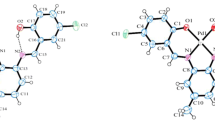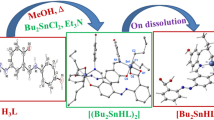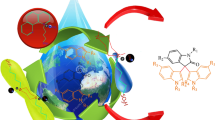Abstract
Formation of novel lower rim derivatives of p-tert-butylthiacalix[4]arene through direct reflux between p-tert-butylthiacalix[4]arene tetrahydrazides (cone, partial cone and 1,3-alternate conformers) and N-methylisatin in absolute ethanol. The study is clearly showed a facile synthesis of di- and tetrasubstituted p-tert-butylthiacalix[4]arene derivatives (2, 3 and 4) with excellent yields (up to 95%). The novel products were investigated by using the state-of-the-art techniques such as FT-IR, 1H-NMR and 13C-NMR spectroscopies. Moreover, the potential applications of these derivatives were screened for their ability to detect and remove alkali and transition metals (Li+, Na+, K+, Cs+, Pb2+, Cd2+, Hg2+, Ni2+, Co2+, Cu2+, Ag+) using the liquid–liquid extraction method with promising results.
Similar content being viewed by others
Explore related subjects
Discover the latest articles, news and stories from top researchers in related subjects.Avoid common mistakes on your manuscript.
Introduction
Design and synthesis of novel functional molecules that could serve as molecular devices for detection of metal ions is one of the most cited areas of research [1]. The detection of metal ions has a wide range of environmental and biological applications [2, 3]. One example for this is thiacalixarene derivatives which can be used as detectors for almost all metal ions. This is due to their high chemical stability and selectivity toward complexation. Also, their structural properties could be tailored through a precise modification of the upper, middle annulus and lower rims [4,5,6,7,8,9]. The lower rim modification of thiacalixarenes skeleton is the most easiest and familiar by insertion of a different functionalization through the hydroxyl groups [10, 11]. These lower rim thiacalixarenes modifications are crucial for improved their metal ions recognition ability. The p-tert-butylthiacalix[4]arene tetrahydrazides [12] are considered as good substrate in modification of the thiacalix[4]arenes through the coupling with carbonyl compounds as well as the addition to unsaturated carbon–carbon double bond or carbon–nitrogen triple bonds [13,14,15]. We should mention here that at the first instance we tried to use product of C–N coupling of isatin with p-tert-butylthiacalix[4]arene tetrahydrazides [16], as we believe that the product of this reaction could be used for the recognition of metal ions. However, the insolubility of this product in non-aqueous media obstacle us to use them in this study. So far, we have prepared new derivatives of these materials via methylation of isatin to facilitate their solubility and hence the possibility to use them for metal ions recognition.
In this work, we aim to synthesis p-tert-butylthiacalix[4]arene derivatives containing N-methylisatin moiety in three different conformers. The activity of the prepared materials was evaluated toward their ability to recognize different metal ions in picrate solutions such as Li+, Na+, K+, Cs+, Pb2+, Cd2+, Hg2+, Ni2+, Co2+, Cu2+ and Ag+ ions.
Experimental
Materials and instruments
All chemicals and reagents were of analytical grade and used as received without any further purification. Melting points (°C, uncorrected) were determined using an open glass capillary via a Barnstead 9001 electrothermal melting point apparatus. Fourier transform infrared (FT-IR) analysis of the prepared compounds was conducted with a Perkin Elmer Spectrum 1000 FT-IR Spectrometer. 1H- and 13C-NMR spectroscopic analyses were performed in deuterated chloroform (CDCl3) at room temperature using JEOL ECP-400 MHz spectrometers. The chemical shifts are expressed in δ 7.28 downfield from CDCl3 and used as a reference.
General method for picrate extraction
Solutions of metal picrates were prepared by pH-meter from aqueous solution of picric acid and metal hydroxide (such as LiOH, NaOH, KOH or CsOH) or metal nitrate (such as Pb(NO3)2,Cd(NO3)2, Hg(NO3)2, Ni(NO3)2, Co(NO3)2,Cu(NO3)2 or AgNO3) solutions. In the latter case, solutions were weakly acidified with a final pH of 4.5. An aqueous picrate solution (5 ml, 1.0 × 10−4 M) and dichloromethane solution of the ligand (5 ml, 1.0 × 10−4 M) were stirred together for 0.5 h and then kept for 0.5 h for phases parathion at 25 °C. Blank experiments showed that no metal picrate extraction occurred in the absence of p-tert-butylthiacalixarene derivatives. The absorbance of the aqueous phase before (A0) and after extraction (Ai) were measured at 355 nm. The percent extraction (E%) was calculated using the following expression:
Synthesis of p-tert-butylthiacalix[4]arene derivatives 2, 3 and 4 (general method)
A mixture of p-tert-butylthiacalix[4]arene tetrahydrazides 1a, 1b or 1c (1.5 g, 1.48 mmol) and N-methylisatin (0.98 g, 6.1 mmol) in a 50 ml ethanol was heated under reflux for 24 h. The separated yellow precipitate was filtered and washed out several times with ethanol.
Characterization
p-tert-butylthiacalix[4]arene derivative 2: (cone) yield 90%; yellow crystals, Mp: 205 °C; IR (KBr): ν = 3398 (NH) cm−1, 32,227.9 (NH) cm−1, 3059.9 (CH arom.) cm−1, 2960.9–2872.1 cm−1(CH-aliphatic), 1691 cm−1(C=O);1H-NMR: δ = 0.87 (18H, s, But), 1.39 (18H, s, But), 1.58 (4H, s, 2NH2), 3.27(6H, s, NCH3), 5.00–5.24 (8H, m, 4-CH2CO), 6.67(2H, d, isatin-H),6.93 (4H, s, Ar–H),7.13 (2H, t, isatin-H),7.40 (2H, t, isatin-H),7.63 (4H, s, Ar–H),7.81 (2H, d, isatin-H)9.47 (2H, s, CONH),12.57 (2H, s, –CONH).13C-NMR: δ = 25.7, 30.8, 31.3, 34.0, 34.4, 34.5, 71.9, 72.8, 108.9, 119.3, 121.2, 123.3, 128.8, 129.3, 130.3, 131.1, 131.4, 132.4, 132.7, 133.9, 136.3, 143.7, 147.5, 148.5, 155.9, 157.9, 160.8, 161.4, 166.7, 169.7. Elemental analysis Calc. for C66H74N10O10S4 is C, 61.18; H, 5.76; N, 10.81, found: C, 61.06; H, 5.63; N, 10.54.
p-tert-butylthiacalix[4]arene derivative 3 (partial cone) with yield of 95%; yellow crystals Mp: 215 °C; IR (KBr): ν = 3233 (NH) cm−1, 3063.7 (CH arom.) cm−1, 2959.9-2873.2 (CH aliph.) cm−1, 1726.9 (C=O) cm−1;1691.1 (C=O)cm−1;1H-NMR: δ = 1.13 (18H, s, But), 1.30 (9H, s, But), 1.35 (9H, s, But), 3.17–3.27 (12H, m, NCH3), 3.79–5.40 (8H, m, –CH2CO), 6.77–7.95 (16H, m, Ar–H, isatin-H). 12.42 (1H, s, –CONH), 12.53(2H, s, –CONH), 13.53(1H, s, –CONH).13C-NMR: δ = 25.85, 25.71, 29.67, 31.13, 31.27, 34.15, 34.54, 58.51, 68.51, 70.79, 71.08, 108.30, 108.59, 108.77, 119.74, 120.99, 121.49, 122.88, 123.15, 128.02, 130.64, 130.92, 132.49, 132.69, 134.41, 134.80, 143.49, 144.55, 145.22, 145.68, 146.70, 147.03, 156.86, 158.41, 158.76, 160.55, 160.78, 160.97, 166.66, 169.46, 169.60, 169.67, 169.77, 169.93. 170.19. Elemental analysis Calc. for C84H86N12O12S4: C, 63.70; H, 5.47; N, 10.61. Found: C, 63.61; H, 5.12; N, 10.73.
p-tert-butylthiacalix[4]arene derivative 4 (1,3-alternate) Yield 95%; yellow crystals Mp: 288 °C; IR (KBr): ν = 3213 (NH) cm−1, 3061.4 (CH arom.) cm−1, 2958.5-2904.9 (CH aliph.)cm−1, 1731.3 (C=O)cm−1;1691.2 (C=O)cm−1;1H-NMR: δ = 1.11 (36H, s, But), 3.16 (12H, s, –NCH3), 5.21 (8H, s, –CH2CO–), 6.75–7.44 (24H, m, Ar–H + isatin-H), 12.37 (4H, s, –CONH), 13C-NMR: δ = 25.66, 31.01, 34.25, 65.95, 108.68, 118.55, 119.79, 121.11, 123.19, 127.95, 129.37, 130.91, 133.99, 143.48, 147.54, 160.91, 169.63. Elemental analysis Calc. for C84H86N12O12S4: C, 63.70; H, 5.47; N, 10.61. Found: C, 63.68; H, 5.51; N, 10.43.
Results and discussions
The reported p-tert-butylthiacalix[4]arene tetrahydrazides 1a, 1b and 1c in three different conformers (cone, partial cone and 1,3-alternate) were prepared as reported previously [12, 13]. Typically, the corresponding conformers were fluxed with N-methylistainin absolute ethanol as a solvent, for 24 h. In case of the cone conformer of the thiacalixarene tetrahydrazide 1a, a steric hindrance was found, because of the existence of four tetrahydrazide groups on the same side (the lower rim) of the thiacalixarene tetrahydrazide skeleton. So far, only 1,3-distal disubstituted p-tert-butylthiacalix[4]arene derivatives 2 was separated. Using the less steric hindrance conformers partial cone1b and 1,3-alternate1c with N-methylisatin obtained tetrasubstituted p-tert-butylthiacalix[4]arene derivatives 3 and 4, respectively (see Scheme 1).
The FT-IR spectra of the product p-tert-butylthiacalix[4]arenes 2-4 (Scheme 1) show the appearing of the isatin-hydrazone fragments carbonyl group at more than 1720 cm−1 in addition to the amidic hydrazide carbonyl groups at less than 1700 cm−1 and other tetrahydrazides functional groups. The 1H-NMR analysis of symmetrical structure 1,3-alternate derivatives 4 (Scheme 1) shows a simple spectra, except the aromatic protons which come from isatin and arenes moiety, there is a single peak for each group of protons (e.g., But, 1.11 (36H, s); –NCH3, 3.16 (12H, s); –CH2CO, 5.21 (8H, s), ppm). The 1,3-distal disubstituted thiacalixarene 2 which was prepared from a symmetrical structure 1a has almost simple 1H-NMR except for the dividing of the thiacalixarene tetrahydrazides proton groups (But, Ar–H and NH) to two different peaks (e.g., But, 0.87 (18H, s) and 1.39 (18H, s); Ar–H, 7.93 (4H, s) and 7.63 (18H, s); NH, 9.47 (1H, s) and 12.57 (1H, s), ppm). In the unsymmetrical structure of 3 which increase splitting as well as multiplicity of the different group of protons, there are three non-equivalent tert-butyl groups which should give a 2:1:1 ratio of resonance patterns in the proton spectrum having But peaks at δ = 1.13 (18H, s), 1.30 (9H, s), 1.35 (9H, s) and also three peaks of NH groups at δ = 12.42 (1H, s), 12.53 (2H, s), 13.53 (1H, s). In addition to the above, the 1H-NMR spectra were measured using D2O as a solvent. The spectra show disappearance of the NH2 and NH groups.
In order to evaluate the ability of p-tert-butylthiacalix[4]arene derivatives 2-4 and to recognize metal ions, a liquid–liquid extraction experiment has been carried out of different metal picrates including (Li+, Na+, K+, Cs+, Pb2+, Cd2+, Hg2+, Ni2+, Co2+, Cu2+, Ag+) from water into dichloromethane by using UV–Vis spectroscopy. The results are summarized in Table 1 and Fig. 1. Although thiacalixarenes 2–4. It shows a poorly extractants for alkali metals, thiacalixarene 4 show selective recognition properties with extraction percentage 40% forCs+metals. Moreover, thiacalixarenes 2–4 show a good extractants for transition metals with a maximum extraction percentage 47% of thiacalixarene 3 for Pb+2 metals and 31% of 2 for Cu+2. These compounds 2–4 are moderately extractants for Hg+2 ranged from 19 to 23% extraction percent.
The concentration of aqueous phase (metal picrate) is 1.0 × 10−4 M and the concentration of organic phase, dichloromethane (ligand) is 1.0 × 10−4 M for 2–4. The percentage extraction is given by (initial aqueous cation)—(final aqueous cation)/(initial aqueous cation) × 100.
Figures 2 and 3 show an electronic absorption spectrum for the extraction of Cs+ and Pb2+ ions by ligands L2, L3 and L4. A Bathochromic shift occurs in the case of Cs+ ion when reacted with L3, where λmax shifted from 355 nm to 400 nm due to the stable complex formation between Cs+ ion and L3 (Fig. 2). A new band established at 305 nm in the case of L3 and at 315 nm in the case of L2 and L4 when interaction these ligands with Pb2+ ion due to complex formation (Fig. 3), whereas these ligands have carbonyl and NH moieties, which acts as electron donating groups and they have ability to catching these ions.
Method of molar ratio was used to study the stoichiometry of the complex formed between 3 and Pb2+ as well as the complex formed between 4 and Cs+. It has been found that the stoichiometry ratio between the ligand 3 and the metal ion (Pb2+) is 1:1 and also the same for ligand 4 and Cs+ (Fig. 4).
Conclusions
In summary, we have successfully synthesized novel p-tert-butylthiacalix[4]arene derivatives via direct condensation of p-tert-butylthiacalix[4]arene tetrahydrazides with N-methylisatin. The obtained products were further confirmed via different techniques such as FT-IR, 1H-NMR and 13C-NMR spectroscopies. In addition, the p-tert-butylthiacalix[4]arene derivatives have shown promising detection ability for various metal nodes with high extraction ability (E%≈ 50%) and selectivity, particularly, for Cs+ and Pd2+ ions.
References
S. Patra, D. Maity, R. Gunupuru, P. Agnihotri, P. Paul, J. Chem. Sci. 124, 1287 (2012)
S.O. Ojwach, S.G. Nyamato, B. Omondi, J. Darkwa, A.O. Okoth, J. Coord. Chem. 65, 298 (2012)
B. Mokhtari, K. Pourabdollah, N. Dalali, J. Coord. Chem. 64, 743 (2011)
C.D. Gutsche, Calixarenes Revisited, in Monographs in Supramolecular Chemistry, ed. by J.F. Stoddart (RSC, London, 1998)
L. Mandolini, R. Ungaro (eds.), Calixarenes in Action (Imperial College Press, London, 2000)
J. Vicens, J. Harrofield (eds.), Calixarenes in Nanoworld (Springer, Dordrecht, 2007)
C.D. Gutsche, Calixarenes. An Introduction (Royal Society of Chemistry, Cambridge, 2008)
Z. Asfari, V. Bomer, J. Harrofield, J. Vicens (eds.), Calixarenes (Kluwer Academic Publications, Dordrecht, 2001)
P. Neri, Calixarenes, Beyond (Springer, New York, 2016)
M. Zhao, J. Lv, D. Shun Guo, RSC. Adv. 17, 10021 (2017)
R. Kumar, Y.O. Lee, V. Bhalla, M. Kumar, J.S. Kim, Chem. Soc. Rev. 43, 4824 (2014)
I.I. Stoikov, R.Z. Nasibullin, V.A. Smolentsev, L.I. Gafiullina, A.Y. Zhukov, J.B. Puplampu, I.S. Antipin, A.I. Konovalov, Mendeelv Commun. 16, 248 (2006)
A.O. Omran, Chin. J. Chem. 27, 1937 (2009)
S.N. Podyachev, N.E. Kashapova, V.V. Syakaev, S.N. Sudakova, R.R. Zainullina, M. Gruner, W.D. Habicher, T.A. Barsukova, F. Yang, A.I. Konovalov, J. Incl. Phenom. Macrocycl. Chem. 78, 371 (2014)
A.O. Omran, F.A. Elgendy, A. Nafady, Int. J. Electrochem. Sci. 11, 4729 (2016)
S.A. Lahsasni, O.A. Omran, Heterocycles 89, 1195 (2014)
Acknowledgements
The authors gratefully acknowledge the approval and the support of this research study by the Grant No. 7300-SCI-2017-1-8-F7 from the Deanship of Scientific Research at Northern Border University, Arar, K.S.A.
Author information
Authors and Affiliations
Corresponding author
Rights and permissions
About this article
Cite this article
Mohamad, A.D.M., Omran, O.A. Synthesis, characterization of novel p-tert-butylthiacalix[4]arene derivatives and its application for extraction of alkali and transition elements. J IRAN CHEM SOC 16, 2197–2202 (2019). https://doi.org/10.1007/s13738-019-01691-6
Received:
Accepted:
Published:
Issue Date:
DOI: https://doi.org/10.1007/s13738-019-01691-6









